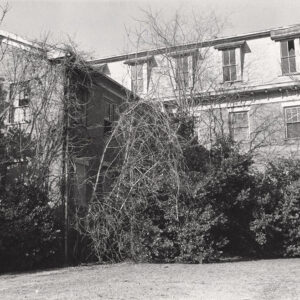calsfoundation@cals.org
Alexander George House
The Alexander George House was a historic home located in Little Rock (Pulaski County). Constructed between 1858 and 1859, the home served multiple functions, including as a hospital and an office for railroad companies. Although it was added to the National Register of Historic Places in 1976, it was demolished in 1994 and removed from the register in 1999.
Alexander George arrived in Little Rock from his birthplace in Germany in 1833 with his father and four brothers. The George brothers operated a variety of businesses in the Little Rock area over the next three decades, including a mercantile, brewery, and beer garden. Alexander George began a construction company in 1853 with John Robbins, and the two men won a contract to construct a wall around the state penitentiary. In addition to their construction duties, the men operated the prison until 1859.
George served multiple terms on the Little Rock City Council, had a stint as the city street commissioner, and helped establish the German Lutheran Church in Little Rock. He married fellow native German Anna Barbara Kuntz, and the couple had at least six children. Confederate forces reportedly placed the cannon Lady Baxter near the house during the Little Rock Campaign in an effort to defend the city. George died on February 16, 1877, and is buried with his wife in Mount Holly Cemetery in Little Rock.
During his time operating the Arkansas State Penitentiary, George constructed his home at 1007 East 2nd Street in Little Rock. The two-story, red brick square building included a two-story rear projection. Facing north, the home included a five-bay façade and originally had a wooden balcony and glass cupola on the roof. A combined slave quarters and kitchen were located behind the main house and connected by a covered walkway. The 1860 federal census recorded George owning six enslaved people: two men, two women, and a boy and girl.
After George’s death, his daughters took ownership of the house but were unable to maintain the home. It was sold in the 1880s, and the Catholic Church purchased the home in 1888 for use as a Catholic hospital. A mansard roof was added to the two-story main structure at this time to provide an operating room for the new hospital, which was known as St. Vincent’s. Operating at the house for just over a decade, the hospital admitted more than 2,000 patients during that period. Needing a larger facility, the hospital moved around 1899.
The Choctaw, Oklahoma and Gulf Railroad purchased the building the following year for use as their headquarters. Located near the Choctaw Route Station, the house continued to serve the Rock Island Railroad when that line bought the Choctaw in 1902. In 1964, the Rock Island sold the house to the Arkansas Building Company, and the building was abandoned. Even though it was added to the National Register of Historic Places on May 28, 1976, the house was never restored. It continued to fall into disrepair and was demolished in 1994. The area where it once stood became a parking lot for the University of Arkansas Clinton School of Public Service. A historical marker was placed near the site of the home.
For additional information:
“Immigrant’s House after Varied Career, Retains Appearance.” Arkansas Gazette, June 18, 1976, p. 18A.
“Little Rock Ante-Bellum House Destroyed for Parking Lot.” Faulkner Facts and Fiddlings 36 no. 3/4 (1994): 100.
Olds, Christine. “George House Is One of Little Rock’s Oldest.” Arkansas Democrat Magazine, May 31, 1964, p. 7.
David Sesser
Southeastern Louisiana University
 Historic Preservation
Historic Preservation Louisiana Purchase through Early Statehood, 1803 through 1860
Louisiana Purchase through Early Statehood, 1803 through 1860 Alexander George House
Alexander George House  Alexander George House
Alexander George House  Alexander George House
Alexander George House 




Comments
No comments on this entry yet.